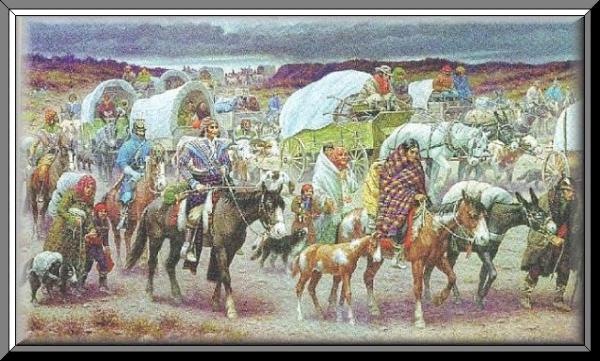 Subject: Technology,
Literature, Social Studies Subject: Technology,
Literature, Social Studies
Grade Level: 7
Materials: Computers with Internet
capabilities and Microsoft Word, Power Point, TimeLiner,
MapMaker, and VideoStreaming software; a printer, projector,
overhead, floppy disk/flash drive, and stopwatch; and the book
The Light in the Forest by Conrad Richter
About: The students are assigned to a
collaborative learning group to research different facets of
the Cherokee Indians, including their removal, known as the
Trail of Tears, and present their findings using a multimedia
presentation format.
The students present a 5-10 minute oral presentation with
the support of a variety of computer resources. They may
utilize: TimeLiner to create a timeline of events describing
the hardships during the Trail of Tears; PowerPoint to create
a presentation explaining the history and present day Cherokee
Indians; or Mapmaker to create a map using today's state
boundaries to highlight the different trails.
In this project, students discover each other's assets and
utilize them to contribute to the group presentation. They
learn about the plight of the Cherokee Indian and how to
incorporate technology into an oral presentation. The students
complete their research via the Internet, downloading
appropriate materials including music, pictures and maps.
This is a great cross-curricular learning experience where
students control part of the class's learning. There is a vast
amount of materials to incorporate and different opportunities
to have each student's talent highlighted. I met each group in
a "pow-wow" where we discussed the possibilities for their
presentation.
| The students research the plight of the
Chrokee Indians and the role of the United States
government in removing them from their native lands. |
| The students read the historical
fiction novel The Light in the Forest by Conrad Richter
to enhance the learning experience and further their
understanding of the time period. |
| The students practice their word
processing and Internet skills such as narrowing
searches, copying, pasting, downloading, jpegs and wav
files, toggling between windows, highlighting, and
printing. |
| The students collaborate as a group,
accentuating individual strengths such as creativity,
leadership, speaking, and technological abilities. |
| The students relate the impact and
hardships of the Cherokee Indians and compare this to
other ethnic groups' hardships. |
|
|
|
|
|
| Here you can find timelines,
maps, statistics, first-hand accounts of the
trail, legends, stories, recipes, and links to
other Cherokee sites. |
| http://rosecity.net/tears/ |
| At this site, you can learn about
the history of the Cherokee Indians from before
the European settlers to the mid-1800s. There are
links to books and Cherokee newspapers. |
| http://cherokeehistory.com/ |
| This is the official site for the
present-day Cherokee Nation in Tahlequah,
Oklahoma. It shares news stories, employment
opportunities, and links to their culture. |
| http://cherokeehistory.org/ |
| This is a geneology site where
you can read about the history of the Chreokee
Indians and view maps, treaties, and timelines. |
| http://rootsweb.com/~itcherok/resource.htm |
| This is a webquest that my
students use as a resource to the lifestyle of the
Cherokee Indians including tribal dancing,
recipes, clothing, and contributions to society. |
| http://catawba.k12.nc.us/techtrac/plus/taylor/outline.htm |
|
|
|
|
|
|
|
| Students read, write, listen, and
speak for information and understanding. As
listeners and readers, students collect data,
facts, and ideas; discover relationships,
concepts, and generalizations; and use knowledge
generated from oral, written, and electronically
produced texts. As speakers and writers, they use
oral and written language to acquire, interpret,
apply, and transmit information. |
| Intermediate |
| ELA |
| Students read, write, listen, and
speak for social interaction, and use oral and
written language for effective social
communication with a wide variety of people. As
readers and listeners, they use the social
communications of others to enrich their
understanding of people and their views. |
| Intermediate |
| ELA |
| Students use a variety of
intellectual skills to demonstrate their
understanding of major ideas, eras, themes,
developments, and turning points in the history of
the United States and New York State. |
| Intermediate |
| Social Studies |
| Students use a variety of
intellectual skills to demonstrate their
understanding of the necessity for establishing
governments; the governmental system of the United
States and other nations; the United States
Constitution; the basic civic values of American
constitutional democracy; and the roles, rights,
and responsibilities of citizenship, including
avenues of participation. |
| Intermediate |
| Social Studies |
| Computers, as tools for design,
modeling, information processing, communication,
and system control, have greatly increased human
productivity and knowledge. |
| Intermediate |
| Technology |
|
|
|
|
|
|
|
|
|
|
|
|
|
|
|
|
|
|
|
|
|
|
| The students meet with their assigned groups
and discuss how they will proceed with their
question for the project. |
| The students begin to research facts and
create a Hot List of any sites they think they
will need for the project. |
|
|
|
|
| Computers with Internet capabilities,
Microsoft Word, note paper, pen/pencil, floppy
disk/flash drive |
|
|
|
|
| In their groups, the students read their
questions and brainstorm their ideas on how to
creatively present their projects. |
| Each student has a computer to begin
preliminary reseach and create a Hot List of
websites they think will help answer the question
for their project. A Hot List is a list of
websites copied & pasted into Microsoft Word
(and hyperlinked) and include a breif description
of what information is on that site. |
| As the teacher, I meet with each group in a
"pow-wow" to help facilitate the groups direction
for the project. |
| At close of class, each group bookmarks any
necessary site and save their Hot List. |
|
|
|
|
|
|
|
| There is no written homework, but students
must be prepared at the end of the next class to
decide what format their project will be completed
in. |
|
| The students are assessed as a group by
listening and collaborating together. Their mark
is an effort and conduct grade. |
|
| Day 2: Presentation
Planning |
| The students have enough research to begin to
develop their multimedia presentation. |
| The students continue to narrow their research
on the Internet. |
|
|
|
|
| Computers with Internet capabilities and
Microsoft Word, PowerPoint, TimeLiner, Mapmaker
software, note papaer, pen/pencil, floppy
disk/flash drive |
|
|
|
|
| In groups, the students log onto the Internet
to research their project question and create a
Hot List of websites. |
| I hold a "pow-wow" with each group to
brainstorm how they will present their project and
what multimedia format would work best for their
question. |
| The students have the opportunity to work on
their presentation in the appropriate software
(PowerPoint, TimeLiner, Word, Mapmaker) |
|
|
|
|
|
|
|
|
| At the close of class, the students have no
written homework, but are encouraged to continue
researching their project question. In both Social
Studies and LIterature, the students are assigned
wiritten homework, which incorporates facts for
this
project. |
|
| The stuents are assessed as a group by
listening and collaborating together. Their mark
is an effort and conduct grade. |
|
| Day 3: Presentations take
Shape! |
| The students work their select multimedia
software to create a presentation for their
project question. |
| The students download pictures, maps, and
music, as needed, for their projects. |
|
|
|
|
| Computers with Internet capabilitiesand
Microsoft Word, PowerPoint, TimeLiner, Word, and
Mapmaker software, floppy disk/flash drive |
|
|
|
|
| The students continue to work on their
presentation in the appropriate software
(PowerPoint, TimeLiner, Word, Mapmaker) |
| I hold a "pow-wow" with each group to ensure
the students are answering the question for their
project and what multimedia format would work best
for their question. |
|
|
|
|
|
|
|
|
|
| Continue research at home, if
necessary. |
|
| The students are assessed as a group by
listening and collaborating together. Their mark
is an effort and conduct grade. |
|
| The students complete their projects and begin
to prepare for their oral presentations. |
|
|
|
|
|
| Computers with Internet capabilities and
Microsoft Word, PowerPoint, TimeLiner, Word, and
Mapmaker software, floppy disk/flash drive,
stopwatch, printer |
|
|
|
|
| The students break into their groups and
complete their multimedia presentation. |
| In today's "pow-wow," I view each presentation
and add critiques to where they could enhance or
improve the final project. |
| Each group prepares and prints a script and
decides who will present the different parts of
the presentation. |
|
|
|
|
|
|
|
|
| The students rehearse their
presentations. |
|
| They receive a grade on their projects using a
rubric. |
|
| The students present their projects by group. |
|
|
|
|
|
| Completed project, computer, projector, and
assessment rubric (for teacher) |
|
|
|
|
| Each group presents their project. |
| At the end of each presentation, there is an
opportunity for question and answers. |
| As a follow-up, the students complete an
analysis report on their learning experience and
the effort of the group. |
|
|
|
|
|
|
|
|
| Each student is graded on the research, oral
presentation, and overall project. |
|
|

Tara Sottnik
HnameofM@optonline.net
Holy Name of Mary School
90 South Grove Street
Valley
Stream, NY 11580
Tara Sottnik has been the Computer Teacher and Technology
Coordinator at Holy Name of Mary School for 9 years. Last
year, Tara was recognized in Who's Who Among America's
Teachers. She attend many conferences and workshops to stay
current with technology and bring new learning experiences to
her students.
Important documents for this lesson plan.
|